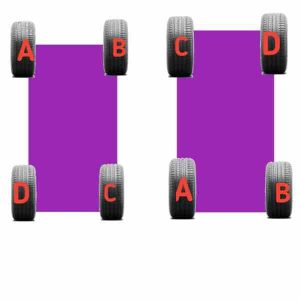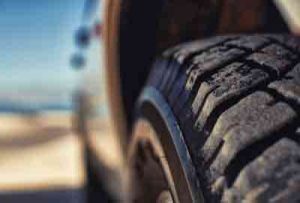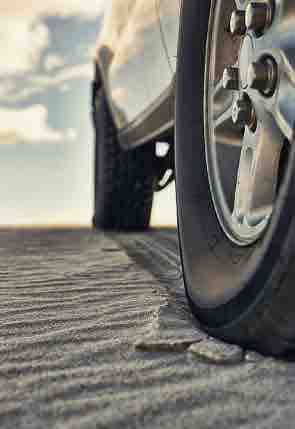It isn’t just about how long you have used the tire or the quality or the way you have used them, there is more to it.
Here are some reasons that you never thought about.
Table of Contents
Why are your rear tires wearing faster than the front tires?
- Your rear tires are not properly aligned
- Your rear tires have not been rotated
- Your car is possibly rear-wheel drive
- Your brakes have an issue
- Your driving habits
- Your rear tires are over-pumped
Your rear tires are not properly aligned
For most drivers or car owners, the only care you give your car is a good scrub at the carwash.
Tires need more than that unless they will give you a headache and affect your car. One of the things that your tires need is proper alignment.
This is not just about how straight your tires are when you park. It is more about the angle your tires are with the rest of the car and the ground.
All tires, and I mean all four of them, have to be parallel to one another so that they form a perfect rectangle, and perpendicular to the ground. Perpendicular means at 90° to the ground.
Now to you, a rookie in anything about the car except the driving and cleaning, you may not know if your tires are actually abiding by this rule so it is best for your mechanic.
Your tires have not been rotated
Tires are not the objects that make the car roll, they matter and they have needs too.
One of these needs is frequent rotation. Rotation is not just about doing a 360 on an empty field.
For those who have no idea what I mean, I will explain. Simply, it is switching the positions of your tires.
Let’s give an example. Front right is A, front left is B, rear right is C and rear left is D. So now we have the positions this is how you rotate: A goes to D, B goes to C, D goes to B and C goes to A.
Here is a diagram to explain.

This helps your rear tires because the pressure on the rear tires is now on the front tires that have been switched. This way they can wear evenly.
Your car is a rear-wheel-drive
You are asking what wheel drive is? Wheel drive is simply where the load of the car rests.
Load doesn’t mean dead weight here, it means power transmitters, you know, things make the car move.
There are two types of wheel drives: front-wheel drive and rear-wheel drive. Cars like Honda, Golf, and Ford use front-wheel drive.
Mazda MX, Porsche, and BMW Series are rear-wheel-drive cars. For cars that are rear-wheel drive, a lot of pressure through speed and acceleration will wear the rear tires faster than the front.
This is not entirely bad as the rear-wheel-drive has some benefits that front-wheel drive doesn’t have so you will only have to bear the disadvantage of the tires.
Your brake system has an issue
The brakes are made of discs, calipers, pads, and a lot of other things that unite to stop the car as the driver pleases.
When any part of the brake system has an issue, it will invariably affect the tires, and the rear tires even more.
How? The worm pads or dislodged calipers will not work effectively and with time make the tires unbalanced.
In this unbalanced state, they will wear unevenly and faster than they normally should.
For the rear tires that are the freeroll, whether your car is a front-wheel drive or a rear-wheel drive, the tires will not respond to the brakes and will wear unevenly and even worse than the front.
Your driving habits
All the times you have overworked your tires or used them for insane stunts that no one else would be proud of, your tires have quietly borne.
Now they are worn and look like they ran 500 miles on the worst roads in the world. With the strain on the tires over a long period of time, the rear tires will wear especially because they are freeroll.
The fact that they don’t have much responsibility like the front tires means that they are open to more harm and they can not do much to protect themselves.
Maybe get a new pair of tires and don’t drive so recklessly so you don’t have to get new tires too often.
Your tires are over-pumped
In the last article, I stated the importance of having even well-pumped tires and why your tire pressure should match the ones on the users’ guide.
Usually, the PSI of the rear tires is more than that of the front tires. If the front tires are bigger than the rear tires the weight and imbalance will affect the tires and the car.
If the rear tires are not pumped according to its recommended PSI, they will wear on the inside first then show signs of wear on the outside.
In general, tires that are not well pumped will be difficult to handle or control.
Why do rear tires wear out on the inside?

Wear on the inside of a car tire doesn’t literally mean the interior where the tube sits but the middle part if the tire, like in the picture.
Here are some reasons your rear tire is wearing on the inside:
- Underinflation
- Poor tire alignment
- Wrong toe settings
Under inflation
This is very common if you don’t take proper care of your car. You just had a flat and you rush off to a vulcanizer or a mechanic to get it fixed and you don’t even check the PSI.
First, it doesn’t matter until your tires look like this, then you realize what you have done but it’s too late because you will need new tires.
You need to regularly check your PSI to make sure that you are not killing your tires. The best way to do it is with a tire pressure gauge.
The tires may look the same when you are done pumping but the tire gauge will tell the truth.
Poor tire alignment
The angle of your rear tires to the ground and other parts of the car matter.
While poor alignment for the front tires will make the car control and misdirection, the rear tires will just wear because they do not do as much as the front tires.
Set at the wrong angle, the rear tires will follow the lead of the front tires and wear unevenly and on the inside.
Wrong toe settings
Although toe settings mostly concern the front tires, there are toe settings for the rear tires of a front-wheel-drive car.
The toe settings of rear tires must be correct for even, gradual wear. This means that it means it must not be a toe in or toe out the tires must be perfectly parallel to each other.
This way they align with the front tires preventing any form of wear. It also improves the acceleration of the car in general.
What causes the rear tire to cup?
Tire cupping or tire scalloping is uneven wear of tires. To explain it simply, see parts of the tires wear more than others so that when you drive, the ride is rough and bumpy.
That up and down motion is called bouncing and it gets worse on slow rides. Now we understand tire cupping, what are the causes of rear tires?
Tires with poor quality
If from the start your tires have not been well made, they will wear faster and unevenly.
Tires are made of rubber and as good as rubber is it has its limit. You will do yourself good to get good tires that will not cave after a few rides.
Shock absorbers are worn out
As the name implies, shock absorbers take in most of the hits and shocks that should normally affect the car.
Why do they matter so much? They matter because, without them, other parts of the car will take damage like the rear tires.
This will lead to more friction with the ground and cupping of the tire
Imbalanced tires
Maybe you have been careful and you have aligned your quality tires, what can still be the cause of the cupping? Imbalance!
Despite extreme care and modern technology, tires tend to have parts that are stiffer than other parts.
This will lead to bouncing when driving, irregular wear also called patch wear, and faster wearing. Ensuring your tires are balanced before you mount them extends the tires life by 10%
Why do rear tires lean in?
For your tires to lean in, a lot of things are wrong. One of them is the arms control and suspension parts.
They are connected to the tires and are needed for control and movement. If anyone of them is damaged you will have to check it out immediately.
Another thing is the camber. If they are damaged too, you will have to replace them and fast because they help in direction and with them damaged, controlling the car will be very difficult.
Also, they may not be damaged but the angle matters. Camber can be negative or positive.
It is a positive camber if the top leans out more than the bottom and it is negative if the bottom leans out more than the top.
Both of them are not good and the angle of the tires has to be adjusted to be parallel to the ground.
Why are my rear tires slanted?
Just like I mentioned above it is because of the camber and in this a negative camber. This can be due to a bad steering wheel, suspension parts, camber, other important parts of the car.
It is advised to give your tires a thorough check-up every 6000 miles to avoid problems like this.
Then again, some cars are made this way: with the tires slanted. Here as long it is not too slanted and every component of the car is working efficiently, so it is okay.
It is also made like this because when turning it gives the car more grip with the ground and helps the driver handle the car better.
Why are my rear tires jumping when turning?
A lot of things are at work in a car when you make a turn no matter how small. For example, the drive shaft sends torque to the tires making them move.
When you make a turn, especially a sharp or hard turn, the driveshaft will reach its limit and twist.
The jump happens when the driveshaft rebounds. During the turn, the brake rotors are also at standstill. It is like a lot of things are dead, and they concentrate on making that nice turn.
You don’t feel it over small or quick turns because they need as much work as tight turns. This can also happen if your differential is locked.
The differential is a bunch of gears that control the tires and help in turning. If the differential is locked just push the button to unlock and your car won’t bounce in the next turn.
Why are my back tires locked?
There are two reasons for this: the brake shoe is contaminated or the wheel bearing is bad.
The job of the brake shoe is to carry the brake lining to the brake drum.
It simply means that when the driver applies the brake, the brake shoe will be pushed outward to the brake drum to cause friction, making it stop.
When engine oil spills into the brake shoe, it reduces the friction and makes the brake ineffective.
A bad brake shoe makes it hard to use the brakes and will affect the tire that will lock on its own whether the differential is locked or not.
The second reason, the bad wheel bearing, speaks for itself. The tires have no direction so even when you want to turn or move the tires won’t respond as they should.
Why are my back tires smoking?
This is dangerous and should be addressed immediately. Ignoring more things going wrong and the whole car breaking down.
One of the causes is the brake pad. Not just it though. Brake pads apply to both the front and back tires.
If any of the rotors should go out of place and make contact with the brake pad, it will become red and bring about smoke.
Another reason is the wheel bearing. It may be completely damaged or it just seizes randomly.
This will be difficult on the tires as they will have no connection or know how to move. This will cause smoking and even the smell of burning rubber.
If this is not attended to immediately, accidents can occur.
Is it bad to have bigger tires at the back?
I have seen many cars, mostly small trucks with back tires bigger than the front.
This may seem cool but it is wrong if it is not according to the PSI of the rear tires.
You know this by checking the seal of the driver’s door or the user’s manual.
The PSI is the amount of pressure recommended for each tire and it is usually more for the back tires but does not vary dramatically.
What is important is that you follow the PSI stated. If you don’t know how to check it just get a tire pressure gauge.
It will give you a good reading. Following the PSI is a great way to take care of your tires.
Conclusion
With all your questions answered, that is all for today. Be sure to read true and use the solutions recommended.
Be sure to leave your questions and comments in the comments section below and I will see you in the next article.
Related topics:
- Why Do My Bike Tires Keep Popping
- Difference Between R20 and ZR20 Tires
- Why are Bicycle Tires Often Inflated to a Higher Pressure

